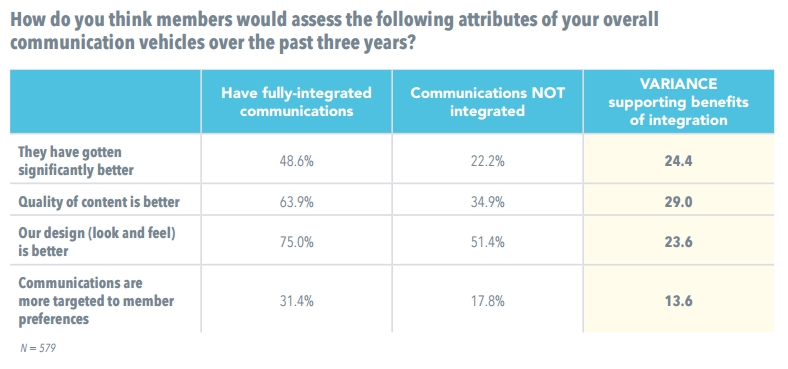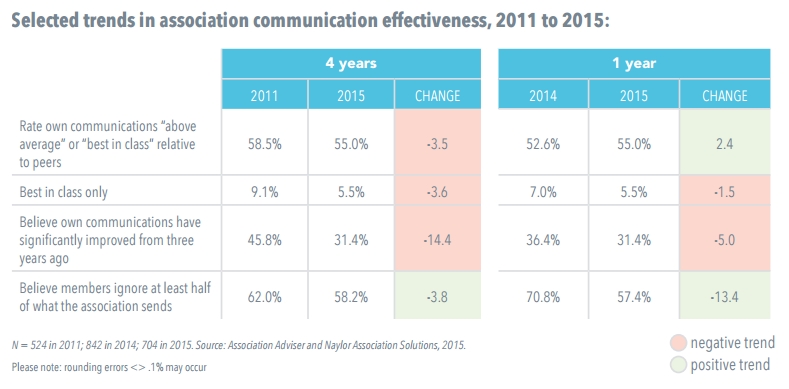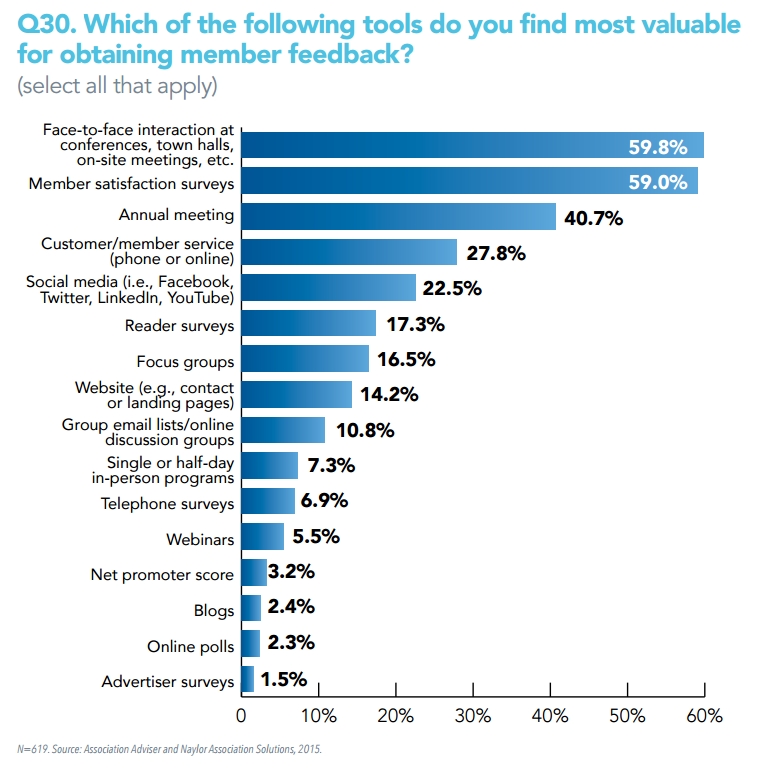Research Confirms: Association Communicators Getting Better

But there’s still plenty of room for improvement.
It’s no secret that associations are trying more ways than ever to stay top of mind with their members. They’re communicating more frequently: they’re using more tools and channels to reach members; they’re doing more audience segmentation, and they’re putting more emphasis on the member engagement experience. They key here is MORE.
![]()
Understand your audience. Not just their age, but their communication preferences; how they hear and how they retain.
Don’t discount traditional media. Many members still crave the tangible feel of print and live interaction at events.
Associations with integrated communication platforms are significantly outperforming those that lack integrated communications.
But, is more necessarily better? Generally no, because you’re just contributing to information overload and communication clutter – two things association members so often complain about. But, if you can find a way to synchronize all of your member communications so that:
- Each vehicle has a well-defined frequency/message/audience/purpose;
- Your content is cross-purposed and cross-promoted as appropriate; and
- Advertisers have the ability to coordinate their media buys across all of your channels, well, then you have a highly effective member communication platform and much higher member satisfaction and retention. And members will probably give you higher marks for the quality, design and relevancy of your content.
You probably have much higher member satisfaction and retention due to your highly effective member communication platform.

Unfortunately, only a small number of associations are fully integrating their communications these days, and as our annual Association Communications Benchmarking Report shows, the number has been going down, not up, over the past four years.

If you download the report, you will see that the level of communication integration among associations continues to decline, just as it has every year since 2011. Today, just one out of every 16 associations (6.1%) claims to have a fully-integrated communications strategy. Compare that to 10.5 percent of associations in 2014 and to more than 20 percent of associations in 2011.
As one respondent from an international healthcare society observed, “You need to understand your audience. Not just their age, but their preferences in communication; how they hear, and how they retain. In my opinion, it’s the toughest part of sharing your story and having it remembered.”
Our 2015 report, which includes the findings from 704 association leaders across nearly 100 industries that completed a 52-question online survey, helps explain why.
Click here to request a copy of the latest benchmarking report.
First a little historical perspective:
- In 2011, we learned that many associations were operating in silos and believed they were doing a better job of integrating their communications programs than they actually were.
- In 2012-13, we discovered that associations greatly underestimated the degree to which overload and communication clutter were preventing them from reaching their members.
- In 2014, we found that associations with truly integrated communications were more effective than other associations when it came to meeting reader/member/advertiser needs.
- In 2015, we learned that social media is eclipsing traditional online media as the leading channel for high-frequency member touchpoints. Further, associations are finally starting to chip away at the longstanding challenges of information overload and communication waste. They’re also getting better at targeting and segmenting their communications efforts, and they’re making a substantial push into video and mobile.
However, associations still struggle greatly with content relevancy, communication integration and using data advantageously to learn more about their members. And while staffing has increased slightly, it does not seem to be increasing sufficiently to handle the ever-increasing communication workload at today’s associations. We also found that a disturbingly large number of associations admit that they do not have a bona fide mobile, social media or video strategy in place. For instance:
- 31 percent said they were “not sure if their members find social media valuable” — up from 26 percent who said so in 2014.
- Less than 30 percent of respondents agreed that members were engaging with their video offerings.
- Just 22 percent said they were pleased with the ROI they were receiving from their video initiatives.
Respondents told us they were more concerned about losing new members than they have been at any time since we began this study in 2011. So, clearly mobile, social and video channels are linchpins of many associations’ initiatives to connect with Next Gen. They’re also good channels for generating revenue. Two in five associations (39%) now have mobile conference apps (up from 35 percent in 2014) and one-third (33%) have optimized their e-newsletters and blogs for mobile devices.
Jason Glei, senior director of marketing, Associated General Contractors of America, told us that AGC has a mobile app sponsor for all of its events. “We also do a sponsored Twitter feed at several of our larger events, and we run sponsored video loops at our events.”
Another respondent, Nicole Malcom, director of operations for the American Holistic Nurses Association told us that AHNA introduced a mobile app during its 2014 annual conference and experienced a 60 percent adoption rate.
Not sure why people are uninstalling your apps? My colleague Brianna Lawson explains.
Our research also confirmed that associations continue to struggle with content relevance, communication segmentation for different member subgroups and with collecting and using data to know their members better. For instance, look at how respondents’ answers have changed over the years when we asked them to rank the five most import topics to their members. Back in 2011, associations thought members were primarily interested in “What’s happening in my industry and in Washington?” Today, it’s more about “What can the association do for me and how can it help me in my career?”
5 Most Important General Topics to Association Members 2011 vs 2015
| Rank | 2011 | 2015 |
|---|---|---|
| 1 | Industry News/Trends | How-To/Best Practices |
| 2 | Lobbying/Advocacy | Career/Professional Development |
| 3 | Career/Professional Development | Industry News/Trends |
| 4 | Member News | Lobbying/Advocacy |
| 5 | Coverage of Industry Events | Actionable Data |
N = 524 in 2011; 704 in 2015 Source: Association Adviser and Naylor Association Solutions
On the bright side, associations are attempting to adapt to the fast-changing media consumption habits, preferences and expectations of their members. As Kurt Nagle, CEO of the American Association of Port Authorities (AAPA) describes in this month’s Corner Office profile story, “We recognize that technology is changing by the day. We need to make it easier for members and policy makers on Capitol Hill to access and digest all of our materials on a device like an iPhone.”
Traditional media still has legs
As association professionals, we tend to obsess about the next shiny object coming down the pike. But one research finding that surprises many folks year after year is the continued prominence of traditional member communication channels such as print magazines, eNewsletters and live events. In fact, out of more than two dozen types of member communication vehicles rated by respondents, only three achieved a score of at least 4.0 on a scale of 5:
- Live conference/trade show: 4.71
- Member magazine (print): 4.13
- Member eNewsletters: 4.04
Two other longtime association media staples – print directories and show guides – each came close at 3.7.
That did not surprise AHNA’s Malcom. “Most members of an association feel the connectivity of what the association offers through a live event, or print magazines or directories,” she said. “That’s because the live event, printed magazine or directory is tangible to them. They can touch, feel and experience the information that normally would only be available to them online.”
Jill Andreu, vice president of content strategy & development at Naylor Association Solutions, agreed. “Regardless of a member’s information consumption preferences, there is still something special about receiving that print directory or magazine – a true, tangible member benefit with great pass-along value.” Andreu added that live gatherings that are able to “morph with the times” will continue to provide valuable opportunities for “collaboration and interaction,” which is what members really crave.
And good old eNewsletters, the granddaddy of electronic media, continue to receive high marks from association professionals (see above). Both Glei and Malcom said their associations’ eNewsletters are the most trusted of their ad-supported member communication vehicles.
Non-dues revenue challenges
AHNA’s Malcom said that selling advertising and sponsorships is especially challenging today because many companies are looking for “the biggest bang for their buck.” They also want “hard data showing that when they place an ad or [pay for] a sponsorship that their company will be visible and recognizable.”
Just as members are getting increasingly demanding, so are advertisers and sponsors. Unfortunately, for the first time since we began this study in 2011, more than half of respondents (53.2%) said they are not asking their advertisers and sponsors consistently if they feel they are getting their money’s worth – a trend line that unfortunately has been continuing.

N=586 Source: Association Adviser and Naylor Association Solutions 2015
That’s unfortunate, because when associations do have the courage to ask, they seem to put that feedback to good use. Our research shows that three-fourths of associations (75.4%) are incorporating advertiser/sponsor feedback to some degree into their rates, pricing and media offerings – up substantially from 59.9 percent in 2014 and 62.3 percent in 2011.
“Associations can no longer get away with just slapping a sponsor’s logo on some signage,” observed Malcom. “Sponsors want to network with attendees and members in a more personalized matter.”
My colleague John Bacon explains why NDR is earned, not sold in today’s issue.

Nothing tops face-to-face for garnering member feedback
According to Naylor’s Andreu, speaking with members at events and meetings provides a sense of “ownership and trust that members want from their association.” However, she said, surveys can help you quantify what you think members are telling you or are hesitant to tell you face to face. AGC’s Glei agrees that anonymous surveys provide the most candor and in today’s Corner Office profile, Kurt Nagle tells more about AAPA’s annual “Relevance Survey.”
AAHN’s Malcom said her organization not only uses member satisfaction surveys and face-to-face interaction at conferences to gather meaningful feedback, they also review member evaluations of their continuing education materials.
Conclusion
If nothing else, make the process of gathering member feedback an ongoing, 365-day-a-year activity, not an annual or semi-annual initiative. Here at Association Adviser we introduce new insta-poll questions every few weeks. We analyze reader feedback and quantitative response to different types of articles, video episodes, interviews and case studies. And before fielding our annual benchmarking study or other research initiative, we reach out to dozens of association leaders to solicit potential questions, to help us formulate hypotheses, and, of course, to help us follow up with respondents after our surveys to obtain verbatim feedback that supplements initial responses to a question.
Thanks for your help. Again, you can obtain a copy of the 2015 report here. Use the comments box below if there are questions you’d like us to consider for the 2016 report.
Hank Berkowitz is the moderator-in-chief of Association Adviser eNews.

